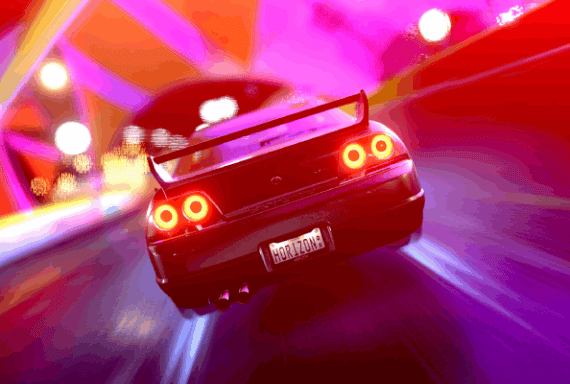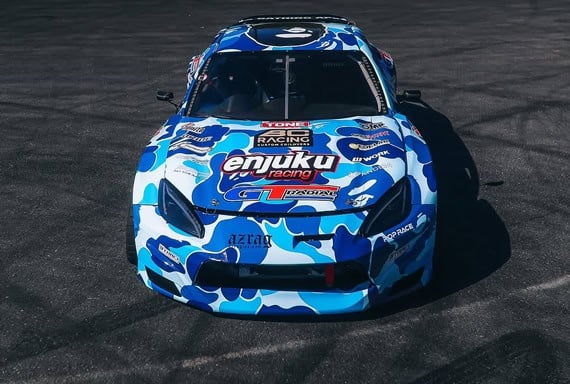The Best JDM Cars Of The Nineties
These legendary 90s JDM cars set new standards for performance and tuning and continue to influence today’s car culture.

- Mazda RX7
- Honda NSX
- Toyota Supra
- Nissan Skyline
- Subaru Impreza
- Mitsubishi Evolution
- Honda Integra
- Nissan Silvia
- Nissan 300ZX
- Honda Civic
- Nissan Pulsar GTI-R
- Honda S2000
- Mazda Eunos (Miata)
- Mitsubishi Eclipse
- Toyota MR2
- Toyota Chaser
The Best JDM Cars Of The Nineties
Drifting enthusiasts undoubtedly consider the 1990s the golden era for JDM (Japanese Domestic Market) cars. Most gearheads consider the ’80s to be too slow, the ‘2000s to be too complicated, and the ’90s to be the sweet spot.
Electric cars were still a distant vision at the tail end of the last decade, and the performance vehicles rolling off the production line in Japan’s powerhouse motor industry were still entirely mechanical.
Want a JDM car for drifting? Try our best drift cars for beginners article
At the time, Japan’s economy was booming, and disposable income was at an all-time high. With the nation’s car owners facing strict vehicle inspections, drivers concentrated on innovation over durability and frequently updated their cars.
According to French research, a car in Japan travels an average of just 5,800 miles yearly, compared to the UK average of 7,900 miles.
This allowed the ’90s market to be geared towards petrol heads, with Japanese manufacturers prioritizing their newly refined technologies and designs for JDM cars before considering the international market.
As these high-performance masterpieces began hitting the streets, little did they know that these cars would maintain an impressive cult following across the world to the present day with ever-increasing prices and popularity.
If you are looking for a top JDM car specifically to put your mark on it and tune it to your heart’s content, then check out our best tuner cars article.
With this game-changing history in mind, let us take you back to the glory days as we check out our best JDM cars of the Nineties. Let’s dive into our top picks!
Mazda RX-7 FD3S

- Model years: 1991-2002
- Engine displacement: 1.3-liter twin-turbo
- Power output: 252-276 bhp
- Drivetrain configuration: RWD
The FD was the third generation of the legendary Mazda RX7. This stylish front-engine, rear-wheel drive sports car attracted a substantial following due to its sleek design and powerful performance.
The RX-7 was noted for its lightweight construction and unique twin turbochargers. It was the first ever mass-produced sequential twin-turbocharger system to come from Japan. The compact and unique rotary engine was housed behind the front axle, which gave the vehicle a 50/50 front and rear weight balance combined with a low center of gravity. And who could possibly hate the pop-up headlights?
The FD accelerated from 0-62 mph in 5.9 seconds, achieving a top speed of 155mph. The twin rotors gave it a wealth of torque throughout the entire rev range. Its innovative construction makes it easy to handle and a joy to drive, and it’s easy to see why so many Madalin Stunt Cars 3 players opt for it as their favorite car in the game.
The Mazda RX-7 became a key JDM car because the engine gave a financial benefit to its Japanese owners. The engine size was below 1.5 liters, making the annual road tax more affordable while offering more power than traditional inline engines.
In Britain, sales were initially slow, but a price drop and word-of-mouth recommendations led to a surge in interest. The RX-7 became so popular that more parallel and grey market models were brought into the country than Mazda UK had ever imported.
Want to see a tuned Mazda JDM RX-7 out in the wild? Check out “Rotary” Rick’s stunning Mazda RX-7 feature.
Honda NSX
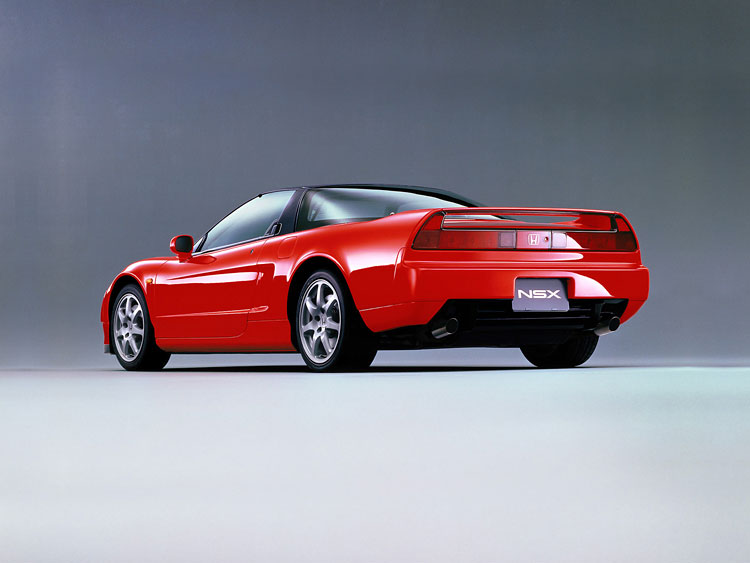
- Model years: 1990 – 2005
- Engine displacement: 3 liters
- Power output: 270-290 bhp
- Drivetrain configuration: RWD
The first-generation Honda NSX bucked the trend of low-budget JDM cars as it was designed to compete against Ferrari’s high-performance models and was marketed as the first “everyday supercar”.
This two-seater mid-engine sports car was more reliable and exceeded the performance of its Italian rivals’ more expensive models despite its lower price. And it had the looks to rival Ferrari’s as well!
Honda achieved this aim using the powerful 3.0 liter 24 valve VTEC V6 engine, which incorporated innovative variable valve timing. They also installed titanium connecting rods, which lowered the reciprocating weight and improved the vehicle’s strength.
This allowed an additional 700 rpm, which brought the engine redline to 8000 rpm. The design of the car’s bodywork was based on the inside of the F-16 fighter jet’s cockpit. It was intended to give 360-degree visibility by moving the cabin forward, and the long tail enhanced directional stability at high speed.
The vehicle accelerated from 0-60 mph in 5.7 seconds, with a top speed of 168 mph.
The NSX was designed to showcase several of the Japanese manufacturer’s automotive technologies, with many taken from its Formula One motorsports division. Honda had significant developmental resources and used them with this model.
Japanese F1 driver Saturo Nakajima and the late Brazilian world champion Ayrton Senna put the vehicle through its paces at the Suzuka race circuit, performing endurance driving to test the chassis tuning.
The Japanese domestic market continued to set trends as the Honda NSX (known on the USDM as the Acura NSX) was the first production car to feature an all-aluminium semi-monocoque unit body, which included a revolutionary extruded aluminium alloy frame and suspension components.
Using aluminium instead of steel saved nearly 200kg in weight in the car’s body alone, while the aluminium suspension arms saved a further 20kg. This lightweight construction made the NSX easy to handle and a pleasure to drive.
Other innovations included an anti-lock brake system and electric power steering. These features meant the Honda NSX was durable, offered great value for money, and quickly became one of the most popular JDM cars. This, in turn, forced Ferrari to up its game, making its cars more reliable and easier to maintain.
I was fortunate enough to own an early black-on-black 1991 NSX for just under four years, back when they were relatively affordable (I traded in my 1999 JDM Honda S2000 (black with red interior if you wanted to know!) plus $10k) and I absolutely loved it. The engine, interior, visibility, ride quality, and handling were all absolutely superb. Because of the aluminium construction, they are also proving to be extremely durable and would make an excellent used car purchase.
One thing to watch out for with the NA1/gen1 NSX is harmonic balancer failure.
The harmonic balancer is a device that helps dampen engine vibrations (it is a piece of rubber that sits on the end of the crank), and over time, it can degrade, fail, and eventually fly off!
This happened to me at 80mph and left me stranded on a motorway with a very sick NSX. This can be replaced pretty easily, so if you do pursue a used NSX, make sure this has been done or that you have the budget to do it.
If you have the funds and you want one of the best Honda JDM cars ever built, the venerable NA1 NSX is an excellent choice for you.
Toyota Supra MKIV

- Model years: 1993 – 2002
- Engine displacement: 3 liters
- Power output: 276-326 bhp
- Drivetrain configuration: RWD
“Is that a Supra??” You bet!
The Toyota Supra is one of the most sought-after JDM cars in the aftermarket scene and had a big effect on the car culture, featuring in video games such as Gran Turismo, Need For Speed, and The Fast And The Furious movies.
Arguably, the fourth-gen Supra is considered by many to be the car that popularized JDM cars in the West.
The fourth generation of the Toyota Supra was a significant departure from its 1980s counterpart. A sophisticated curvaceous look and a large rear wing replaced the previous boxy styling.
The car was redesigned to emphasize performance and featured the legendary twin-turbocharged 2JZ engine. The twin turbos worked sequentially, boosting the engine and enhancing torque. The vehicle accelerated from 0-60 mph in 5.1 seconds, with a top speed of 156 mph.
Toyota went to great lengths to reduce the weight of this new model. Aluminium was used extensively, and other measures included hollow carpet fibers, a magnesium-alloy steering wheel, a plastic petrol tank and lid, a gas-injected rear spoiler, and a single pipe exhaust.
Despite having more features than its predecessor, such as dual airbags, traction control, larger brakes, wheels, tires, and additional turbo, it still weighed in at 91kg lighter. This made it heavier than the Mazda RX7 and the Honda NSX, but it still featured fantastic handling while retaining a comfortable grand tourer aspect.
These cars are well built and make an excellent used purchase today. For newcomers to the Supra, the price tag for entry has become eye-wateringly high. If you want a slice of that buttery smooth, tuner’s heaven 2JZ-GTE – then maybe it’s time to call the bank.
Nissan Skyline GT-R

- Model years: 1989 -2002
- Engine displacement: 2.6 liters
- Power output: 276 bhp
- Drivetrain configuration: AWD
The Nissan Skyline GT-R was produced between 1969 and 1973 as a touring car, with the later models known as the legendary “Kenmeri.” The model was revived in 1989 due to the brand’s desire to dominate motorsport.
Three generations of vehicles were made, and they quickly became flagship Nissan performance cars.
The R32 model was designed to compete in Group A racing, the R33 updated the vehicle’s styling, and the R34 lured enthusiasts partly because of its in-depth onboard analysis system and great looks. The car showcased many advanced technologies, such as the ATTESA E-TS all-wheel-drive system and SUPER-HICAS four-wheel steering.
The Skyline GT-Rs culminated a decade’s worth of motor racing knowledge, cementing the model’s status at the forefront of JDM cars.
The final iteration of the Skyline GT-R was the BNR34, more commonly referred to as the “R34”. This stunning car was smaller in dimensions and lighter than its R33 older brother and came with a chiseled design that has become extremely desirable.
How desirable? Some limited edition “NUR” versions of the R34 have recently sold for over $500k USD at auction!
The Nissan Skyline GT-R has become an iconic JDM sports car, being named by Top Gear “as the only true Japanese contribution in the line of supercars” and by Jeremy Clarkson as “one of the best cars in the world.”
While Honda might have a problem with the first part of that statement, I think we can all agree that the Nissan Skyline GT-R is something special, regardless of its chassis code.
You can learn more about getting your hands on your own “Godzilla” here: Why are Nissan Skylines illegal in the United States?
Subaru Impreza WRX STI

- Model years: 1992-2000
- Engine displacement: 2 liters
- Power output: 247-276 bhp
- Drivetrain configuration: AWD
The performance-orientated Subaru Impreza WRX STI was designed to compete in the World Rally Championship (WRX stands for World Rally eXperimental). Innovative technology made it a rallying legend, such as an all-wheel drive drivetrain, stiffened suspension, and a turbocharged engine.
The Subaru Tecnica International (STI) models were exclusive JDM cars unavailable outside Japan. They were upgraded from the standard WRX model with performance-tuned engines, transmissions, and suspension systems.
There are many versions of Subaru’s Impreza, from lightweight specials like the Type RA to the holy grail and now collectors car – the widebody 22B.
The Subaru Impreza was successful in the rally scene and popular with street racers. It even found fame on the big screen after featuring in The Fast & The Furious and Edgar Wright’s cult heist film Baby Driver.
The UK car company Prodrive has recently released their take on the ultimate classic Impreza, the Prodrive P25. This insane car is a JDM fan’s dream and comes with a suitably out-of-this-world price tag.
Mitsubishi Lancer Evolution VI

- Model year: 1999-2001
- Engine displacement: 2 liters
- Power output: 276 bhp
- Drivetrain configuration: AWD
This sports sedan was the Subaru Impreza’s arch-rival. It featured turbocharged inline four-cylinder engines and a five-speed manual gearbox. The sixth generation was updated to improve cooling and engine durability.
It received new bodywork, and the substantial fog lights were reduced in size and moved to the corners for better airflow.
The Tommi Makinen edition was named after the Finnish racing legend after he won four World Rallying Championships for Mitsubishi.
This version came with 17-inch Enkei white wheels, a faster-spooling titanium turbine, a lower ride height, and a quicker steering ratio.
All these improvements meant that the Mitsubishi Lancer Evolution was stronger and more impressive than ever.
These models quickly became significant JDM cars as they were initially limited to Japan. However, specific demand from grey import markets led to them being sold in the UK, Europe, and the USA.
If you like the Mitsubishi Evolution VI, you will love the upgrades in Mitsubishi Evo VIII! If you’re a movie buff, check out this article about the red EVO from Tokyo Drift.
Honda DC2 Integra Type R

- Model years: 1995 – 2001
- Engine displacement: 1.8 liters
- Power output: 200 bhp
- Drivetrain configuration: FWD
The Honda DC2 Integra Type R was introduced exclusively to the Japanese domestic market and is widely acclaimed as one of the best front-wheel drive cars ever created. The Type R variant had a standard 200 PS engine equipped with a close ratio five-speed manual transmission and a helical limited-slip differential.
It was a significant upgrade from previous Integra models and boasted improved performance and handling. Not to mention, it had the edge on the looks department as well.
The extensive changes included a strengthened chassis, reduced weight (this was achieved through using reduced sound insulation, a thinner windscreen, and lighter wheels), more power, a hand-built engine, revised intake and exhaust systems, and suspension upgrades. The VTEC technology allowed the engine redline to boast an impressive 8500 rpm.
Type R was updated again in 1998. The main changes were a re-designed rear bumper, 16-inch wheels, bigger brakes, and higher gear ratios. A further update in 2000 included a revised intake camshaft and more finely balanced drive shafts.
Honda lost money on every DC2 Integra Type R sold because of increased manufacturing costs due to its hand-finished production. The DC2 was critically acclaimed for its legendary handling and high-revving engine and took its place amongst the best JDM cars of the Nineties.
Nissan Silvia
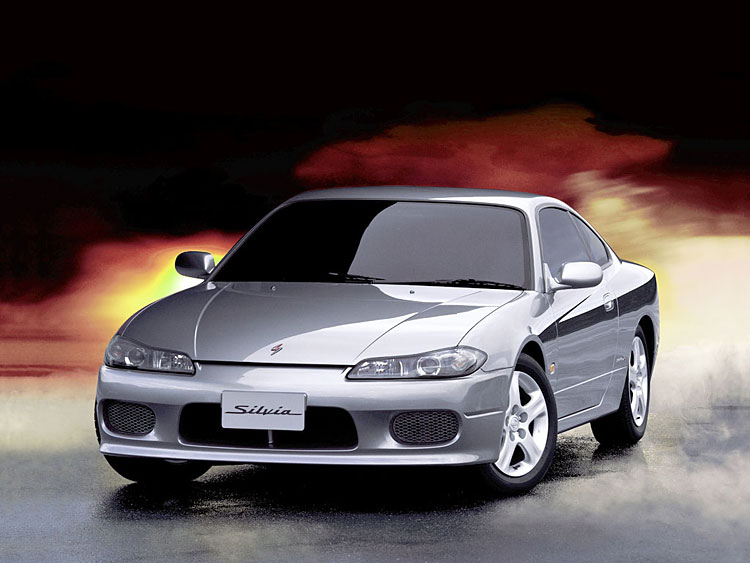
- Model years: 1989-2002
- Engine displacement: 2 liters
- Power output: 133-247 bhp
- Drivetrain configuration: RWD
It was an instant hit in Japan and won the nation’s Car of The Year Award in 1989. This two-door sports coupe also made a huge impression on the drifting scene as owners modified it to compete in competitions or on the touge.
The first 90’s model was initially introduced as the Silvia S13, featuring the CA18DET engine, which was later updated with the SR20DET, which also featured in the later S14, S14A, and S15 models, which featured variable valve timing technology.
Owners chose turbocharged or naturally-aspirated 1.8-liter engines for CA engines and 2-liters for SRs. Buyers could also spec a five-speed manual transmission or a four-speed automatic gear ratio. A close-ratio six-speed manual was also added for the S15.
A limited-slip differential was also available with some models, which allowed drivers to drift the car right out of the showroom.
The Silvia is remembered as a low-slung sports car that helped to bring an incredibly affordable chassis to the masses. In car culture, the Nissan Silvia family became the darlings of the drifting scene and is featured in many drift-themed video games. The Nissan Silvia S13 is one of the most popular cars to be picked in the Drift Hunters franchise.
The final Silvia, the S15, is now well sought after and commands high prices for clean examples.
It is now popular amongst fans of JDM cars from their Nineties heyday.
Japanese tuners have been pushing the envelope with the Silvia S15 for years. This Kazama Auto built Silvia S15 feature is one of my favorites.
Nissan 300ZX

- Model years: 1989 – 2000
- Engine displacement: 3 liters
- Power output: 300 bhp
- Drivetrain configuration: RWD
Nissan continued their emphasis on the Japanese domestic market with the 300 ZX. They utilized the Cray-2 supercomputer and a form of CAD software, making it one of the first production cars to be designed using this tool. It was a new design, with a rounded body and fewer hard edges.
This second-generation model retained the turbo-charged V6 engine of its predecessor but was more upmarket, being faster, larger, capable, advanced, and much higher priced. Four-wheel steering was available with Super HICAS (High Capacity Actively Controlled Steering) on the twin-turbo models.
It was also offered without the turbocharged engine and as a hard top, T-top, or convertible, like many sports cars of the period. It accelerated from 0-60 mph in just over 5 seconds, with a top speed of 155 mph, making it one of the fastest Japanese sports cars of the 1990s.
Along with impressive speed figures, it’s an excellent all-rounder due to its well-tuned chassis, sport-orientated suspension, and active rear steering. It was a leading exponent of JDM cars and featured several trim variants unavailable on the international market.
These included the “Version R” with Recaro seats, leather rear seats in the four-seater, and larger side skirts.
Honda EK9 Civic Type R
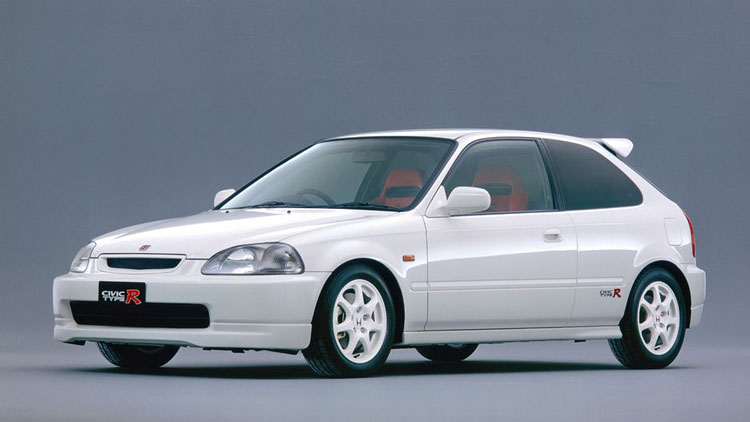
- Model years: 1997 – 2001
- Engine displacement: 1.6 liters
- Power output: 182 bhp
- Drivetrain configuration: FWD
This is the highest-performance version of the Honda Civic, and it was at the forefront of JDM cars because it was unavailable outside Japan. It is a three-door hatchback with a lightened and stiffened body, specially tuned engine, and upgraded brakes and chassis.
The model was designed on sporting lines, with the interior featuring a wealth of red fittings and a stylish leather-wrapped steering wheel.
A red badge accentuated this distinction and differentiated it from other Honda models. This emphasis on sporting success continued in 1998 when the Motorsports edition was released. It featured steel wheels but no air conditioning, power windows, power steering, radio, and the standard Type R interior.
Like its counterpart, the Integra Type R, the Honda Civic Type R was modified to fit Honda’s vision of a car capable of high performance on the racetrack. Other similarities between the two vehicles were the omission of sound-deadening and other weight-reduction measures, a hand-ported B16B engine, a front helical limited-slip differential, and a close-ratio five-speed manual gearbox.
These made the model more stable and reduced wheel spin while racing. The B16B engine generated one of the highest power outputs per liter for a naturally aspirated engine, with 182 bhp. In a further innovation, for the first time, a strategically seam-welded monocoque chassis was used to improve the car’s rigidity.
If you could tone down the paint and styling, a tuned Civic could make for an excellent street sleeper.
Nissan Pulsar GTI-R

- Model years: 1990 – 1994
- Engine displacement: 2 liters
- Power output: 186-227 bhp
- Drivetrain configuration: AWD
This fourth-generation Pulsar shares many characteristics with the Nissan Skyline GT-R, such as its hardcore all-wheel drive and turbo-charged ethos. It is a triumph of substance over style – it’s certainly not the prettiest car out there!
This small pocket rocket makes up for its lack of style in sheer power and driver enjoyment, and the Nissan Pulsar (its name refers to a pulsating star) built up an enthusiastic following in Japan.
Its cult status developed despite little promotion from the manufacturer. This unpretentious five-seater hatchback was specifically produced to enter the World Rally Championship. It accelerates from 0-60 mph in 5.4 seconds, with a top speed of 144 mph.
Honda S2000

- Model years: 1999 – 2009
- Engine displacement: 2 liters
- Power output: 237-247 bhp
- Drivetrain configuration: RWD
It may come as a surprise that Honda features again in our list, but it’s a testament to how impressive they were back in the ‘90s – launched in 1999, the S2000 narrowly makes the cut-off.
In many ways, we feel that the S2000 was underrated and underappreciated, with the F1-inspired F20C engine becoming the highest-powered naturally aspirated production engine ever built at the time.
Before Ferrari launched the 458 Italia, the S2000 held this title for a mind-blowing ten years.
Despite the Ferrari’s higher total output, the 9,000 rpm F20C produces 123.5 HP/L, compared to the 458 Italia’s 124.5 HP/L, making it incredible value for money in comparison!
Besides its impeccable 50/50 weight distribution and awe-inspiring engine, the S2000 is indisputably pleasing to the eye.
In the same time that Honda sold 3.1 million Civics, just 66,860 S2000s rolled out of the showroom in the US before Honda ceased production, making them somewhat rare and increasingly sought-after.
We do not doubt that the S2000 will go on to become a future classic, and if you’re considering getting your hands on one, you’ll want to check out our S2000 tuning guides to discover their true potential.
Spoiler alert: You could potentially aim for 700 horsepower – imagine that in a two-seater roadster!
Mazda Eunos (JDM) / Miata (US) / MX-5 (EU)

- Model years: 1989 – 1997
- Engine displacement: 1.6 – 1.8 liters
- Power output: 116 – 128 bhp
- Drivetrain configuration: RWD
The next entry is arguably the cutest car on this list. But don’t be fooled by the MX-5’s “Anime girl” looks! This little machine delivers one of the best driving experiences you can ever have behind the wheel of a JDM car.
The Miata (or the JDM Eunos) is the best starting point if you want an affordable and fun Japanese roadster from this era. However, nice examples have crept up in price in recent years, so keep an eye out for that.
The first-gen Miata, known as the “NA, ” initially came with a 1.6-liter gasoline powerplant under the hood. In subsequent years, Mazda gave this tiny roadster a more peppy 1.8-liter engine, producing 128 horsepower and 110 lb-ft of torque.
This car was built from the ground up to give drivers a fun time behind the wheel. All the power was sent to the rear wheels only, through either a five-speed manual or a four-speed automatic. But, let’s be real – who the hell wants an automatic MX-5?
Miatas are surprisingly versatile. Whether you want a drift missile or a time-attack car, this JDM classic has you covered. We must also mention that the aftermarket support for the Mazda Miata is unparalleled.
As mentioned earlier, values have started to creep up in recent years. However, if you look hard enough you’ll probably find a diamond in the rough for mere pocket change – just keep an eye out for rust!
Mitsubishi Eclipse

- Model years: 1995 – 1999
- Engine displacement: 2.0 – 2.4 liters
- Power output: 140 – 210 bhp
- Drivetrain configuration: RWD
Anyone who watched the first Fast And Furious probably understands why the Mitsubishi Eclipse earns a spot on this list. Love it or hate it, the car was a cornerstone in popularizing the JDM culture.
Our American audience may know this car as the Eagle Talon. Both cars were the same underneath, with minor differences in their appearance.
Buyers could pick up this sleek, stylish two-door coupe in three trim levels. The fastest one was named the GS-T and came with a turbocharged inline-four that produced an impressive 210 horsepower and 214 lb-ft of torque.
In addition to the improved performance, the GS-T came with some additional creature comforts as well. Leather upholstery and a factory-installed sunroof are two that come to mind.
Although the Eclipse as we know it is no longer produced, you can pick up one of these cars and relive the glory days of Mitsubishi’s performance.
Toyota MR2

- Model years: 1989 – 1999
- Engine displacement: 2.0 – 2.2 liters
- Power output: 156 – 218 bhp
- Drivetrain configuration: RWD
The Toyota MR2 has more in common with the Ferraris and Lamborghinis of the time than its Japanese cousins. Why? Because the MR2 had its engine not in the front but behind the driver. Its name stands for “Midship Runabout 2-seater” after all!
The MR2 of the 90s was one of the most stylish cars around. And its mid-engined, rear-wheel drive layout provided one of the best driving experiences ever. The car was agile and responsive and the snap oversteer kept drivers on the edge at all times.
Questioning whether the MR2 is a good tuning platform? Think again! A host of engine-swapped MR2s are driving around, some producing ridiculous amounts of power. Want to see it for yourself? Take a look at the Honda K-swapped MR2 above.
Toyota Chaser JZX100

- Model years: 1996 – 2001
- Engine displacement: 2.0 – 2.5 liters
- Power output: 138 – 276 bhp
- Drivetrain configuration: RWD/AWD
The Toyota Chaser JZX100 might look like your typical Japanese executive sedan, but underneath that sleeper exterior lies one of the most capable drift platforms ever created.
Launched in September 1996, the JZX100 was the final evolution of the Chaser lineage, sharing its ‘X100’ chassis with the Mark II, Cressida, and Cresta.
Toyota offered several interesting JZX100 variants, from the entry-level 2.0L Tourer with its snoreworthy 138-horsepower 1G-FE engine, to the naturally-aspirated 2JZ-GE (non-turbo 2JZ) powered Avante G 3.0L.
The luxury-focused Avante line even included an all-wheel-drive variant called the Avante Four. In 1997, Toyota added the rare LX100 model, featuring a 2.4L turbodiesel engine. However, the Tourer V is typically the one that holds a special place in the heart of drift enthusiasts.
Equipped with Toyota’s awesome 1JZ-GTE engine the Tourer V features the single-turbo, 2.5-liter version of the Supra’s famous 3.0L 2JZ. With its CT15B turbocharger, the straight-six pushes out 276 horsepower and 280 lb-ft of torque.
Paired with a deceptively light 1,450 kg chassis, it creates the perfect power-to-weight ratio for sideways action straight from the factory. With some engine upgrades, perhaps even considering a 1.5JZ with 600+ horsepower potential, it’s about as much fun as you can have in a four-door.
The Chaser’s rare combination of practical four-door design and drift-ready mechanics makes it special. The coveted manual transmission option, introduced in late 1998 with the R154 gearbox, has become particularly sought-after in the drift community.
The TRD sports edition, featuring unique factory Toyota Racing Development bits, represents the holy grail for collectors. However, finding an unmodified TRD example, or JZX100 in general, is increasingly difficult, as most have been converted for drift use. Not that we’re complaining!
While the Chaser shares its mechanical DNA with the Toyota Mark II (just ask Daigo Saito about his insane 1000hp Mark II), the Mark II sports a different exterior.
When production ended in 2001, Toyota replaced the JZX100 with the controversially-styled Toyota Verossa, which only lasted until 2004, marking the end of an era for one of Japan’s most capable and popular drift platforms. These days, clean examples command premium prices, especially manual variants.
The Chaser’s sublime blend of everyday practicality and drift potential has cemented its status as a JDM legend, proving that sometimes the best drift cars come in unexpected packages.
For those of you who are forced to buy a “sensible” family car with four doors – here’s your perfect sleeper to keep the wife happy!
No wife and kids? Well, you know what they say – more doors, more… *ahem*
Frequently asked questions for JDM cars
Do you have a burning question about JDM cars? If so, this section is written just for you:
What are the best JDM cars?
Since the 90s was arguably the most impressive era in the history of JDM cars, 15 of the best JDM cars are already featured in this article. However, you’ll undoubtedly notice that some true classics are missing from this list.
Cars such as the “Drift King,” Keiichi Tsuchiya’s weapon of choice – the Toyota AE86, feature alongside honorable mentions such as the Mazda RX-7 FC, Lexus LFA, and the various GT-Rs that fall outside of this era, notably the legendary KPGC10 “Hakosuka.”
What are JDMs?
JDMs are cars sold on the Japanese Domestic Market (JDM), some exclusively sold in Japan and never available to purchase elsewhere.
What are cool JDM cars?
We feel that all the cars we’ve featured on this list are cool. Still, newer JDM models launched since the 90s, including the Nissan 350Z, Honda S2000, and the R35 GT-R, are also fantastic choices!
What are the best Nissan JDM cars?
Many believe that Nissan is the ultimate JDM manufacturer, bringing cars such as the Nissan Silvia, Nissan Skyline GT-R, Nissan 300ZX, and the Nissan Pulsar to the JDM market.
What are JDM cars?
A JDM car comes from the Japanese Domestic Market and is often exported overseas to popular markets, such as the US and UK. True JDM cars are right-hand-drive, but over time, the term “JDM” has been used to describe any Japanese car, even the USDM (US Domestic Market) models.
In North America and Canada, JDM cars are often referred to as “imports.”
What does JDM stand for?
JDM stands for Japanese Domestic Market. This is a generic term that doesn’t just apply to cars.
Are JDM cars legal in the US?
JDM cars can be legally imported into the United States once they reach 25 years of age or older.
Is Nissan a JDM?
Nissan is a JDM brand. The Nissan Motor Company Ltd is a Japanese multinational car manufacturer headquartered in Nishi-ku, Yokohama, Japan. Nissan sells cars to most Western automotive markets.
Want more JDM cars?
Okay, while it isn’t a performance car by any measure, the Toyota Alphard is the perfect 90s JDM hauler, especially for those of you who are older and have a family now.
Let’s look at the facts:
- 3.5L V6 engine delivering nearly 300bhp
- Crazy JDM styling
- Plenty of seats
- ALL the luxury
- 12 cup holders
I rest my case.
Like smaller JDM cars? Then you have to check out our JDM kei cars guide.
Photography credits
Drifted would like to extend thanks to the following sources for the use of their images:
- topspeed.com
- wsupercars.com
- jalopnik.com
- gtrnissanskyline.com/r34-gtr
- autoevolution.com
- rac.co.uk
- beautifullyengineered.tumblr.com
- supercars.net
- motortrend.com
- cnet.com
- influx.co.uk
- nissan.co.uk
- Tokumeigakarinoaoshima


 (20 votes, average: 4.25 out of 5)
(20 votes, average: 4.25 out of 5)







